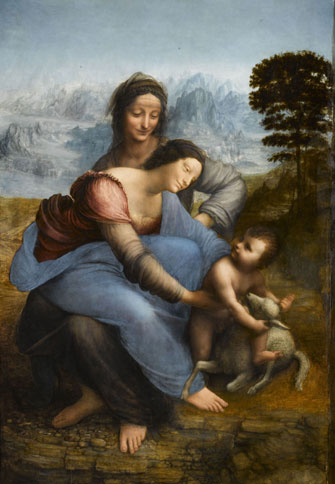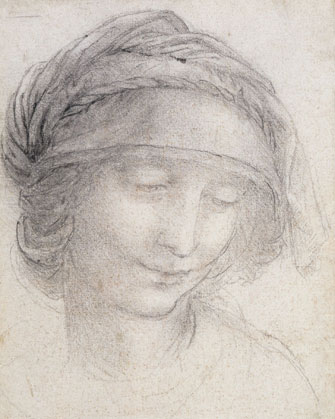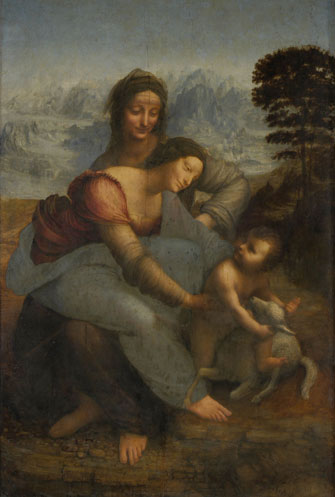The Trinity
Before and After

The restored version of Leonardo’s ”Virgin and Child with Saint Anne” © RMN, Musée du Louvre/René Gabriel Ojéda
To celebrate the unveiling of Leonardo da Vinci’s newly (and controversially; more on that later) restored “Virgin and Child with Saint Anne,” the Louvre has put together an impressive exhibition, “Saint Anne: Leonardo da Vinci’s Last Masterpiece,” that rivals the recent blockbuster at the National Gallery, “Leonardo da Vinci: Painter at the Court of Milan,” itself inspired by the restoration of the London museum’s version of “The Virgin of the Rocks.”
Those who didn’t make it to the London show can console themselves in Paris, where some of the same works are on display – in a rare instance of cross-Channel cooperation between the two museums, they even collaborated on their respective shows and lent each other some of their most precious works.
Beyond showing off the restored “Saint Anne,” the purpose of the Louvre’s exhibition is to put the painting in context. It begins by showing earlier depictions of the “trinity” of the Virgin, her mother and the Christ child – some of them stiff statues and paintings in which the Virgin is shown as a child-sized adult – to demonstrate how Leonardo broke with tradition in his version. Then we have a number of preparatory drawings, some by the master himself and some by members of his studio, which effectively prove his superior

Study for the Head of Saint Anne.“ The Royal Collection. © Her Majesty Queen Elizabeth II
skill, especially the achingly lovely heads of Saint Anne and the Virgin, with the same sweet expressions that have been preserved in the final painting.
Eventually we get to the room where the pièce de résistance hangs. Next to it is the National Gallery’s beautiful “The Burlington House Cartoon – Virgin and Child with Saint Anne and John the Baptist,” which demonstrates how Leonardo’s plan for the painting evolved: in the cartoon, the Virgin and her mother are sitting up straight, and St. John the Baptist is being blessed by the Christ Child. In the final work, the Baptist has disappeared and the Virgin leans across her mother’s lap and reaches out lovingly to the Christ child, who looks back at her while his arms stretch out in the other direction, holding the lamb he is playing with. The scene, with its diagonal thrust from the upper left to the bottom right, is full of life and movement, while the expressions on the figures are full of love.
The restoration of the painting was controversial because some thought it had been over-restored, including two members of the museum’s own restoration advisory committee, who quit in protest. We will leave that argument to the experts, however. To the ordinary art lover, the painting looks ravishing. Compare it with the large photograph of it before restoration (hanging in the same room)
 ”Virgin and Child with Saint Anne” before restoration. © RMN, Musée du Louvre/René Gabriel Ojédato see how it has changed, primarily in the brilliance of the colors and the revelation of details. The dark, grayish-blue of the Virgin’s skirt, for example, is now a gorgeous bright blue.
”Virgin and Child with Saint Anne” before restoration. © RMN, Musée du Louvre/René Gabriel Ojédato see how it has changed, primarily in the brilliance of the colors and the revelation of details. The dark, grayish-blue of the Virgin’s skirt, for example, is now a gorgeous bright blue.
While the painting is thought to be unfinished – Leonardo worked on it for some 20 years and brought it with him to France, where he died in 1519 – many details are extremely refined. Take a close look at the ruffled edging on the Virgin’s dress, for example, the lamb’s wool and the rows of curls on the baby’s head.
The Louvre’s version of “The Virgin of the Rocks” (of The Da Vinci Code fame) is on show as well, along with the museum’s other Leonardo paintings (including “Saint John the Baptist” but not “Mona Lisa,” who remains behind bulletproof glass in her usual spot).
Another star of the show is the copy of the “Mona Lisa” belonging to the Prado in Madrid. Its recent restoration made it clear that it had been painted in the studio alongside Leonardo by one of his students, so the changes made to it as it was being painted (revealed by infrared reflectography) offer a peek into the decisions made by Leonardo as he worked. The copy is rather awkwardly painted and would never be mistaken for the real thing: the famous lady’s face is plumper, for example, and she looks a little cross-eyed. The revelations about this painting have contributed to the official redating of the “Mona Lisa” by the Louvre, from 1503-06 to 1503-19.
Many other copies of and homages to Leonardo by his contemporaries and succeeding generations follow. Their quality varies, but many are masterpieces in their own right, among them works by Raphael and Michelangelo. From the 19th and 20th centuries, we see works by Eugène Delacroix, Edgar Degas, Odilon Redon, Max Ernst and others.
You will leave this exhibition with a greater understanding of Leonardo’s genius and influence. Don’t miss it.
Musée du Louvre: Hall Napoléon. Métro: Palais-Royal-Musée du Louvre. Open Wednesday-Monday, 9am-6pm (until 10pm on Wednesday and Friday). Closed Tuesday. Admission: €11.00. Through June 25. www.louvre.fr
Reader Reaction: Click here to respond to this article (your response may be published on this page and is subject to editing).
Please support Paris Update by ordering books from Paris Update’s Amazon store at no extra cost. Click on your preferred Amazon location: U.K., France, U.S.
More reviews of Paris art shows.
© 2012 Paris Update
Favorite